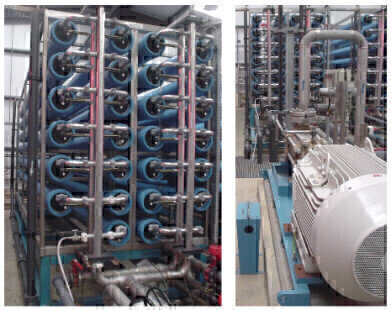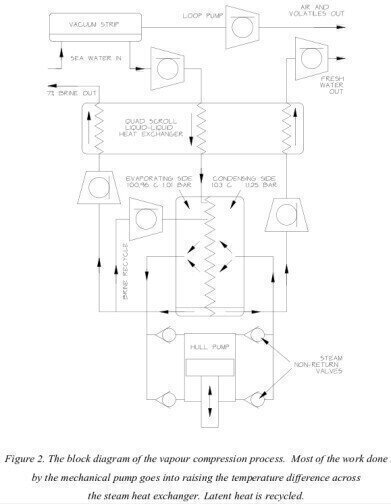-
 Part of the reverse-osmosis facility at Jersey Water’s desalination plant. The pump in the foreground, right, has a power of 355 kW and shoves seawater at a pressure of 65 bar into 39 spiral-wound membranes in the banks of blue horizontal tubes, left, delivering 1500 m3 per day of clean water. The clean water from this facility has a total energy cost of 8 kWh per m3. (From Sustainable Energy - without the hot air)
Part of the reverse-osmosis facility at Jersey Water’s desalination plant. The pump in the foreground, right, has a power of 355 kW and shoves seawater at a pressure of 65 bar into 39 spiral-wound membranes in the banks of blue horizontal tubes, left, delivering 1500 m3 per day of clean water. The clean water from this facility has a total energy cost of 8 kWh per m3. (From Sustainable Energy - without the hot air) -
 Figure 2. The block diagram of the vapourcompression process. Most of the workdone by the mechanical pump goes into raising the temperature difference across the steam heat exchanger. Latent heat is recycled. (Image credit - Stephen Salter)
Figure 2. The block diagram of the vapourcompression process. Most of the workdone by the mechanical pump goes into raising the temperature difference across the steam heat exchanger. Latent heat is recycled. (Image credit - Stephen Salter)
Water/Wastewater
Longitude Prize 2014: Water Challenge
May 30 2014
Clean water is crucial not only for humans' direct use but also for agriculture. Attention often focuses on drinking water, but agriculture is far bigger.
Let's put it in numbers. How much drinkable water do you require for drinking and for cooking? Perhaps a few litres per day per person. In the UK, urban consumption of water is about 160 litres per day per person. And in developed countries, even if they are being careful with water, agriculture requires about 340 litres per day per person. [Israel uses roughly 1000 million m3 of water per year for agriculture, and it has a population of roughly 8 million. That's 340 litres per day per person.]
Some lucky countries have plenty of rainfall, so this agricultural requirement can be provided at very low cost. But what if the water for agriculture must be produced by desalinating sea-water?
Standard reverse-osmosis facilities have an energy cost of 8 kWh per m3, so an agricultural water requirement of 340 litres per day per person implies an energy requirement of about 2.7 kWh per day per person, if we had to make it all by desalination with today's technology. To put that in UK terms, 2.7 kWh/d/p is roughly 17% of the average UK electricity supply; delivering 2.7 kWh/d/p of electricity to the UK would require roughly 7 extra nuclear power stations the size of Sizewell B, or 13,500 2-MW wind turbines.
For people in a less-developed country, the cost of desalinating that much water would be significant - 2.7 kWh/d/p might cost about 30 pence per day per person. More than a billion people live on less than a dollar a day.
This is why the Longitude Prize 2014 water challenge sets the goal of desalinizing water with significantly less energy than today's technologies. We are especially interested in approaches that could low-enough in cost not only at large scale but also when rolled out in small-scale facilities.
For an example of an inventive approach to the Water Challenge, Stephen Salter has published a wave-powered desalination invention (2007) using vapour-compression desalination in place of reverse osmosis. (See second image).
Vote for water now at www.bbc.co.uk/horizon
About the Author
David MacKay FRS is a member of the 2014 Longitude Committee. He is the Chief Scientific Advisor at the Department of Energy and Climate Change, and Regius Professor of Engineering at the University of Cambridge. He is well known as author of the popular science book, Sustainable Energy — without the hot air.
Digital Edition
IET 34.2 March 2024
April 2024
Gas Detection - Biogas batch fermentation system for laboratory use with automatic gas analysis in real time Water/Wastewater - Upcycling sensors for sustainable nature management - Prist...
View all digital editions
Events
Apr 30 2024 Melbourne, Australia
Apr 30 2024 Birmingham, UK
May 03 2024 Seoul, South Korea
May 05 2024 Seville, Spain
May 06 2024 Minneapolis, MN, USA

















